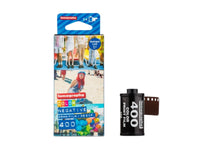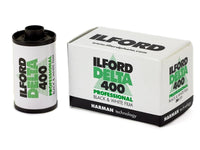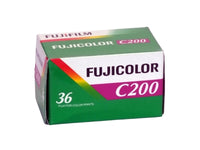Black Friday 2025 has landed at Analogue Wonderland, bringing some of our biggest film photography deals of the year - from discounted film and cameras to money-saving WonderLab processing offers, exclusive bundles, and festive specials available for a limited time only. Grab a great deal while stocks last!
Recent posts
Shop the article

Which 35mm Film Should I use?
By Emma Lloyd
Which 35mm Film Should I use?
In this blog we will help you decide what 35mm film to choose, looking into factors such as subject matter, shooting conditions and the overall aesthetic you are after. You may wonder what 35mm film is still available, and the answer is LOTS. At Analogue Wonderland we stock more than 120 different 35mm films, so there is plenty of choice, and this blog will help you find the 35mm film that is right for YOU.
What is 35mm film?
Before we get started, a quick summary… What is 35mm film? 35mm film is the most popular format of film that we sell. It comes in convenient light tight metal canisters that hold strips of photographic film. The strips of film measure approx 1.6 metres (less for a 24 exposure roll) and are perforated with sprocket holes on the long edges, this is what helps to transport the film in the camera. Each roll of 35mm film can take between 24-36 exposures (photographs) and sometimes a couple of extra shots if you are lucky!

35mm film comes in a variety of film types from black and white negative, colour negative, to slide and reversal film. We even stock some unusual 35mm that uses paper backing! What 35mm to choose can be a tricky one when there is so much choice, but never fear we are here to help with that!
To find out more about this wonderful format check out our blog Is 35mm still made? And other common questions
Which 35mm film?
If you find yourself asking “what 35mm should I buy?” then first take a step back and consider these three main questions:
- What subject are you shooting
- What lighting and weather conditions are you shooting in and
- Do you want to shoot in colour or black and white?
- Optional! - do you have a specific aesthetic/look for your photos?
- What is the purpose of your shoot? Are you looking to create a timeless look with B&W, experiment with fun emulsions or expired film stocks, or opt for a professional grade film?
This last one may only make sense with a specific shoot or project in mind, and if you feel like you’re getting lost in the detail then don’t worry - the first three questions are enough to get a very good idea of which 35mm film to buy!
1. What subject are you shooting?
Are you shooting portraits, landscapes, doing a bit of street photography or something else entirely? The subject matter you are shooting is a variable that will influence what 35mm film to choose. The subject matter will be part of the overall aesthetic you are aiming for and you can use this to help plan ‘the vibes’ of your shoot. Of course there are infinite possibilities of what you could be shooting, but to keep things simple we have broken this section down into 3 main subject matters: portraits, landscapes and street photography.

(c) Colleen Freer, Lomo Colour Negative 400
Portraits
As always with photography, your unique artistic desires for the shoot are the most important thing to keep in mind. But for portraits film photographers are typically looking for: fine detail, good presentation of mid tones and an accurate rendition of skin tones. You want a film that will as close as possible mirror the light and atmosphere of the situation you are photographing.
For portraiture you will most likely be taking quite still and composed photographs. This means you will be able to work with a slower film and longer shutter speed, enabling you to capture lots of lovely details in your beautiful model. You may also be working under bright studio lighting, which will also allow for a lower ISO film that doesn’t need as much light to take good photographs. However, if you are doing something a bit different and taking portraits at night or in low light scenarios, there are still some high speed options available such as Portra 800 or CineStill 800t.

(c) Izzie Farr, @Izzie_Farr, CineStill 800t
With portraiture, an important factor to consider is how your film will render skin tones. For example Portra (clues in the name) has been formulated for portraiture photography and to produce accurate skin tones. However, due to the historic prejudices in society, which of course also fall into the photographic industry- it is important to take into account that these films have predominantly been balanced for white skin, and there may be other emulsions that will more accurately render darker skin tones.

(c) Karen Freer, @LGBTQ_Faces_of_Bristol, Portra 400

(c) Serge Chabert, Portra 800
When talking about this subject on a #SheHeartsFilm photowalk, Ektar was recommended by @cherylegair as being her preferred emulsion for capturing darker skin tones! Sandra Coan, also did a case study on Kodak’s Ektachrome and how it renders darker skin tones. Ektachrome is a slide film, which are notoriously less forgiving than colour negative films, but don’t let that put you off! Slide films produce beautiful images, Sandra Coan describes the film as producing colours that are ‘rich, vivid and very true to life’ and being a great competitor for the Portra emulsions, you can read her blog here.

(c) Erwan S, IG: @erwnstein, Kodak Ektar
Check out our recommended film for portraits here
Landscapes
There is nothing better than dreamy landscape photography. Actually scratch that, there is- dreamy landscape photography on film! Landscape photography can be incredibly captivating and transport you to a whole new place. When choosing what film to use for landscape photography there are a few things to think about: grain, dynamic range and film sensitivity.

(c) Emma Lloyd, Portra 400
Grain is a very important element to think about, particularly if you are taking wide-angle landscape shots and want a high resolution photograph, hence you will want to keep the grain structure as small as possible. If you are interested in black and white landscapes, the Ilford Delta range is a great place to start, featuring their modern emulsion that is created with finer grain to provide sharp black and white images with excellent contrast. Grain is less important if you are doing other kinds of outdoor photographs, as the loss of finite detail won’t be as noticeable.
Dynamic range- this means the contrast ratio between the darkest and brightest colour tones in an image. For example, across a scene in a landscape you might have a bright blue sky, and some shadowy areas under a tree for instance, and you want a film with the capability to capture both of them. So the more dynamic range the better, you can always increase your contrast later on through editing or in the dark room. However, expanding the dynamic range is much more difficult, you may not be able to recover highlight and shadow detail so it is best to get this right within the exposure.
The film sensitivity is probably going to be quite low, because you are working outdoors and will have a lot more light to work with, and slow film addresses the two factors above. Bringing a tripod along for landscape photography is also a good idea, enabling you to get the best from your gear and capture some beautiful scenes, long exposures with no blur or camera shake.

(c)Emma Lloyd, Ilford Delta 400
Check out our recommended film for landscapes here
Street Photography
Street photography could have a bit of an overlap with landscape photography, depending on what subject matter you are looking to capture. For example, architecture- you may also want a film with a small grain structure that can capture lots of texture and detail. If, however you are looking to capture a bit more of the goings on of busy city life, some portraits and action shots, you will want a faster film that can cope with city pace.

(c) Scott Benjamin @scottjakebenjamin, Ilford HP5 Plus
Check out our recommended films for street photography here
2. What weather or lighting conditions will you be shooting in?
Lighting and weather conditions are a crucial factor to consider when picking the right 35mm film for you. The light will determine what film speed you (ISO) you need to get well exposed photographs.
ISO explained
To better explain how different lighting conditions require different speeds or ISO films, have a look at the table below. The figures assume you are using a camera with a set aperture of f/11 or f/16 and the shutter speed 1/60, as this is the typical settings of a point and shoot camera (an ideal camera to start your 35mm journey!). The table shows what ISO is needed to achieve good exposure in different light. You will see the product descriptions of a lot of the point and shoot cameras we stock recommend an ISO between 100-400.
This table is based on an aperture of f/16 and a shutter speed of 1/100.
Light | Beach/Snow | Sunny | Light clouds | Heavy clouds | Indoor- bright | Indoor-normal | Indoor- dark |
| ISO | 50 | 100 | 200 | 400 | 800 | 1600 | 3200 |
The lower an ISO* is, the less sensitive it is to light. Hence, when shooting in bright conditions you won’t need a very high ISO because the film has enough light to work within its surroundings. This also means that you have to adjust your aperture and shutter speed to let more light onto the camera's image sensor. Whereas in dark conditions, like a concert or gig you will need a higher ISO that is MORE sensitive to light, so that it can make the most of all the light in the scene and form a good exposure.
*NB: it is worth noting that on some older cameras the ISO may be listed as ASA instead. ASA and ISO are both measures of film’s speed or sensitivity to light. ASA was a scale used by the American Standards Association, but is no longer widely used. Now most films are labelled ISO, which was created in 1987 by the International Organization for Standardization.
3. Do you want colour or black and white images?
Starting with this question can quickly rule out some options for you. Both colour and black and white film have an enormous range of creative options to play with. There are different factors to consider with each film type which will impact the overall look and aesthetic of your photographs.
Colour: Saturation
Colour saturation refers to the intensity and purity of the colours displayed in an image. Not all colour films have the same colour profile. For example Kodak is known for having warmer tones whereas Fuji is often cooler. The higher the saturation of colour, the more vivid and intense it is. The lower the saturation, the closer it is to grey on the greyscale.
Below are some examples of different colour emulsions so you can compare how they each render colours differently.

(c) @Louis Meehan @louis_meeehan, Kodak Gold

(c) Louis Meehan, @louis_meeehan Fujifilm Fujicolor C200
Black and white: Spectral sensitivity, contrast and grain
Although black and white films are obviously all black and white, they see films in different ways across the colour spectrum, this is known as spectral sensitivity. This is important to keep in mind, so that you choose the film best suited to the environment or subject that you are shooting.
Panchromatic
A panchromatic emulsion produces a realistic colour rendering of the whole scene, as it sees light across the whole colour spectrum, as the human eye would see it (although with no colours). It is sensitive to all colours including red.
Orthochromatic
Orthochromatic films work differently because they are only sensitive to green, blue and violet light. They do not see red light at all. This makes them a great film for at home developers, as you are able to safely load the film under a red safelight without exposing any of your film, as the film is not sensitive to red.
Orthochromatic film can work particularly well for portraits, as where the film cannot see reds in skin tones or facial features such as the lips, it will render them deep greys or even black if you have some red lippy on, and create some dramatic photographs. Panchromatic sees all colour on the visible light spectrum, so will create a more even range of tones across the image.

(c) Thomas Wesley, @thomwesley, Ilford Ortho 80 Plus
Contrast and Grain
Contrast is another big factor to consider with black and white films. Contrast refers to the difference between the brightest parts (whites) and darkest parts (blacks) of an image. If there are more visible details in an image then it's considered to be lower contrast, if there are less visible details then the contrast is high.

(c) Joe Horner, Washi S
Check out our recommended films for contrast here
Finally we have grain. Think of grain like analogue pixels, they affect the overall resolution of an image. The higher the ISO of a film, the more grain there will be. Some photographers are a big fan of grain, as it lends itself to the general aesthetic of film photography and distinguishes it from digital photography, others may prefer a crisp, high resolution image.

(c) Leigh Reke, Ilford Delta 3200
Check out our recommended films for grain here
4. Aesthetic: Traditional or experimental?
And finally... are you looking for the classic film aesthetic or something more experimental? Amongst our amazing range of 35mm films we also stock some more unusual and quirky film brands. If you are looking for a film that adds some more colour to your photos, or special effects such as lightning or snow shapes, want to add some texture to your film or even superimpose images on top like love hearts then we have lots of options for you. Have a look at Lomography, Dubble film, revolog and BKIFI for brands offering something a bit more unique…

(c) Hetty Earwicker, @hettyearwicker35mm, Dubblefilm Solar

(c) Charli Morachnick, @shootphotos_notguns, Revolog Nebula

(c) Jez P, jellyscout_uk, Lomography Purple
Check out our recommended experimental films here
What camera are you going to use?
Although 35mm films will fit into all 35mm cameras, there are still things you need to consider to make sure you are shooting the appropriate film for your camera. The main thing to keep in mind is whether your camera has the necessary ISO settings. For example, some of the simple point and shoot cameras that have become popular recently recommend shooting films within an ISO range of 100-400 (100 for sunny conditions and 400 speed and above for normal conditions). So this camera wouldn’t be suitable for a super fast speed like Ilford Delta 3200.
Some older cameras might also have limitations, as they were made at a time before such fast films were introduced, so you may not be able to go up to very high ISOs. So it is always worth checking your camera's capabilities when choosing the right 35mm film for you.

A collection of beautiful film cameras from a #SheHeartsFilm walk, spot some medium format ones in there too! And maybe even an APS camera...
Why 35mm film is better than digital?
This is a pretty loaded question! And being Analogue Wonderland, we may be slightly biased… Shooting with 35mm offers so many benefits and a completely different experience than shooting digitally. It allows you to slow down the whole shooting process and shoot more mindfully. I personally like its limitations, I know I only have a certain amount of shots so I am encouraged to think about my subject and composition more than with a digital camera. There is the nostalgia and history of film and the awesome camera gear that is passed down through generations! There is the science and precision of film photography, allowing you to go into all sorts of avenues from dark room printing, to experimenting with chemistry as part of at home developing. Film photography will allow you to hone your photographic skills as you learn the manual settings of your cameras and are forced to slow down. Plus you will be joining an incredible community of film photographers… need I go on?
Try the WonderBox: our 35mm film subscription!
If you are still unsure what 35mm film to get then our WonderBox film subscription is the answer. Every other month you will receive a box packed with 6 different 35mm films, analogue goodies and exclusive discount flyers. It is the perfect chance to experiment and see which 35mm is right for you. You will also get the chance to join our exclusive VIP facebook group and enter our monthly photo competition, guest judged by figures in the film community. It is a wonderful way to explore 35mm film, learn, be inspired and welcomed into the film community.

Hopefully this blog has pointed you in the right direction of which 35mm to buy! There is so
much creative potential with film, don’t feel restricted by the recommendations- experiment, play and find a film that you love, that suits the aesthetic you are looking for! It can be an overwhelming choice with so many options available, so if you are still unsure feel free to get in touch with us via help@analoguewonderland.co.uk or via the live chat and we will be very happy to give you some more advice! Happy shooting!
Ready to dive in?
Keep Reading
View all
Christmas 2025: Shipping & Opening Hours
Christmas 2025 is fast approaching! To make sure your analogue goodies arrive in time, take note of our last shipping dates, plus opening and operating hours over the festive season. We've got everything you need to gift the magic of film photography this Christmas!

Film Photography Christmas Gift Guide 2025: Analogue Wonderland
Capture the magic of Christmas with film - no filters needed. Our 2025 Film Photography Christmas Gift Guide 2025 is packed with thoughtful presents for every type of shooter, from curious beginners to seasoned photographers. Discover film stocks, cameras, and creative accessories that will make this festive season truly memorable.
Subscribe to our newsletter 💌
Sign up for our newsletter to stay up to date on film photography news, sales and events:
Free Tracked Shipping
On all UK orders over £50
Passion For Film
An unbeatable range and an on-site lab
Our Customers Trust Us
Thousands of independent 5* reviews
All Deliveries are Carbon Neutral
Independently audited and verified by Planet
- Opens in a new window.








1 Comment -
Dyfed •
I am new to film, I have a canon sure shot 105 that takes 35mm dx film, and I’m getting a canon 1000f SLR 35mm. But can I use the same film in both?